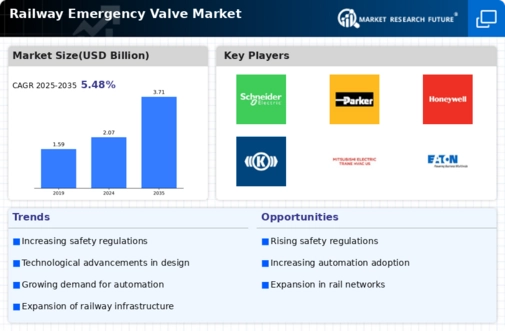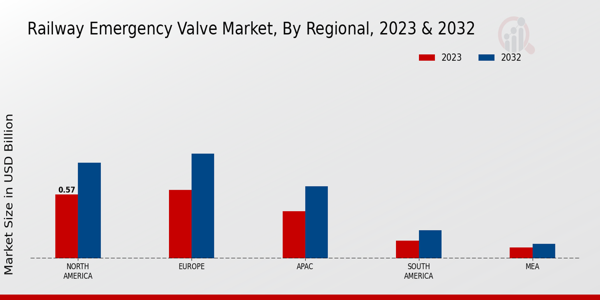Market Trends and Projections
The Global Railway Emergency Valve Market Industry is characterized by several notable trends and projections. The market is expected to reach a valuation of 2.07 USD Billion in 2024, with a steady growth trajectory leading to an estimated 3.71 USD Billion by 2035. This growth is underpinned by a compound annual growth rate of 5.46% from 2025 to 2035, indicating a strong demand for emergency valves driven by safety regulations, technological advancements, and infrastructure expansion. These trends suggest a dynamic market landscape, where innovation and investment play crucial roles in shaping the future of railway safety.
Rising Investments in Rail Safety
Rising investments in rail safety initiatives are significantly impacting the Global Railway Emergency Valve Market Industry. Governments and private entities are allocating substantial resources to enhance safety measures across rail networks. This includes funding for the installation of advanced emergency valves, which are essential for rapid response during emergencies. The emphasis on safety is reflected in the increasing number of safety audits and compliance checks, further driving the demand for reliable emergency systems. As a result, the market is likely to experience robust growth, supported by these investments aimed at safeguarding passengers and cargo.
Growing Demand for Safety Features
The Global Railway Emergency Valve Market Industry is witnessing an increasing demand for enhanced safety features in railway systems. As rail networks expand, the need for reliable emergency systems becomes paramount. Emergency valves play a crucial role in ensuring passenger safety and minimizing accidents. Governments worldwide are implementing stricter regulations regarding safety standards, which drives the adoption of advanced emergency valves. This trend is expected to contribute to the market's growth, with projections indicating a market value of 2.07 USD Billion in 2024, reflecting the industry's commitment to safety and innovation.
Expansion of Railway Infrastructure
The expansion of railway infrastructure globally is a key driver for the Global Railway Emergency Valve Market Industry. Governments are investing heavily in upgrading and expanding rail networks to accommodate growing passenger and freight traffic. This expansion necessitates the installation of advanced safety systems, including emergency valves, to ensure operational safety. As new railway lines are constructed and existing ones are modernized, the demand for reliable emergency valves is expected to rise. This trend aligns with the projected compound annual growth rate of 5.46% from 2025 to 2035, highlighting the market's potential for sustained growth.
Technological Advancements in Valve Design
Technological advancements are significantly influencing the Global Railway Emergency Valve Market Industry. Innovations in materials and design are leading to the development of more efficient and durable emergency valves. These advancements enhance the performance and reliability of valves under extreme conditions, which is critical for railway operations. For instance, the integration of smart technologies allows for real-time monitoring and automated responses in emergency situations. As a result, the market is poised for growth, with an anticipated increase to 3.71 USD Billion by 2035, indicating a robust demand for cutting-edge valve solutions.
Increased Focus on Environmental Sustainability
The Global Railway Emergency Valve Market Industry is also being shaped by an increased focus on environmental sustainability. Rail transport is recognized as a more eco-friendly alternative to road and air transport, leading to a surge in its adoption. As rail systems strive to reduce their carbon footprint, the demand for efficient emergency valves that minimize leaks and emissions is growing. This shift towards sustainable practices is likely to drive innovation in valve technology, ensuring compliance with environmental regulations. Consequently, the market is expected to benefit from this trend, fostering a more sustainable railway ecosystem.













